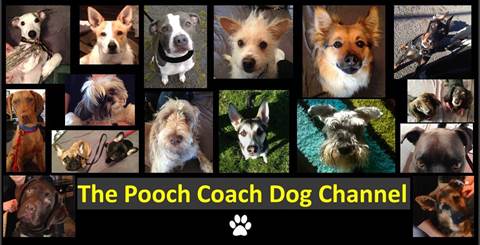The Pooch Coach believes in developing a mutual trust and respect between a dog and his or her owner. I use positive reinforcement along with many tricks and techniques I have learned over my lifetime of studying and working with dogs.
I've created a form of teaching that I call "empathic dog training". I help you deeply understand and relate to what your dog is thinking and feeling so that you can truly understand your dog and his or her actions. This provides for a greatly improved connection with your dog, and makes it much easier & quicker for you to help your furry friend overcome any issues you're having.
Also, your dog should want to follow your commands out of love and respect for you, not from bribery or fear. It's all a balance. Just as you would raise a child and teach him right from wrong, good manners, and safety, you should teach your dog. Gentle guidance, repetition, rewards and clear redirection is how dogs (and people) learn best.
Please read "How to Raise a Dog" for a more thorough explanation of the Pooch Coach's methodolgy.
Please read "How to be a Calm Leader" for insights into how your emotional state feeds into your dog's energy and state of mind.

Contact us for help today!
See some samples of my methology on our YouTube Channel

Do you treat your dog like a child?
You should.

Continuing
Education for your dog*
...one of the reasons The Pooch Coach's
methods work.
Just
as you hear that exercising both your mind and body will help
you live longer and healthier, the same is true for your dog. Dogs
need mental stimulation on a daily basis just like they need physical
exercise every day. Studies have shown that dogs who play and interact
with people on a regular basis are healthier, smarter and live
longer than those that do not. So, how can you keep your dog in
top shape? Here are some of the things I prescribe for my clients.
The
first rule of thumb is something you've undoubtedly heard before
"make your dog work for everything", or "nothing
in life is free". A more positive spin that I like to put
on this is "use every opportunity to train and interact with
your dog". This means if your dog wants affection, teach
him to sit politely next you - not to jump up, paw at you, or
bark and whine. Those behaviors should be ignored so that they
diminish. Reinforce the good behaviors instead. When your dog
is playing well by himself, go join in! Reward him for being a
good dog and grab the toy and start a game of fetch - or make
him sit or lay down to get it back. Believe it or not, your dog
will love this. Dogs used to work for a living, so we need to
give them jobs to keep them satisfied and to keep them out of
trouble. So, create work for them!
Some
assignments I give my clients are:
-
Ask
your dog to sit and stay for every meal. By waiting a minimum of
5 seconds to a maximum of at least one minute, your dog gets
to practice "stay" twice a day for the rest of his
life.
-
Ask your dog to sit and stay before opening the door to go outside.
Once the door is wide open, wait up to one minute before releasing
him to walk behind you out of the door. Training him to do this
means that he's more calm starting out on the walk, he learns
to never run through an open door and, lastly, he learns to
ignore distractions, such as people or dogs or cats running
by out front.
-
Teach your dog to ask permission to come up on the couch, bed
or enter other special areas. He must sit politely and wait
to be asked to jump up or enter the room. This also avoids problems
like a glass of red wine being thrown from a guest's hand when
your dog decides to jump up and visit.
-
Any
time you want to give the dog a treat, bone, pet, put on a leash,
or any other desired activity, make him sit or down or even
shake or rollover first. Making it a fun game to get a toy or
treat will enhance its value to your dog even further…
he worked for it, so now he really wants it!!
-
Be
consistent with your rules so that there is no question in your
dog's mind what you want and expect from him.
Another
way to look at this is that English is a foreign language to a
dog. And, just as with any new language, practice makes perfect.
Plus, if you do not practice, you will get rusty very quickly.
So, keep your dog's vocabulary growing and keep talking to him
throughout his life.
Lastly,
it's also important that we keep our dogs in shape with respect
to safe handling. Most people learn that you should touch a puppy
everywhere - especially paws, tail and mouth - so that she will
be comfortable being poked and prodded by Vets, groomers and children.
You also might have heard that it's good to pet a puppy while
he's eating or chewing on a bone… and even take away the
food or bone to ensure that she does not snarl, bite or otherwise
try to protect it. This is commonly known as "resource guarding".
The problem is that most people stop after ensuring the puppy
or new dog is OK with these actions. Then, a few months or years
go by, someone goes to pet your dog while she's next to her bone
and… SNAP! The reason? The people didn't keep practicing.
My guidelines are to mess with your dog's food at least once a
week for her whole life, and take every chewy (rawhide, bully
stick, Greenie) away from her at least once during her chew. This
ensures you can safely take away items that are dangerous as well
as enables your pet to be around people in all circumstances with
no fear of her snapping at anyone due to trying to protect her
property. They key is to teach her that nothing is her property
to begin with, so there are never any misunderstandings. A great
way to work on this is to teach your dog to "drop it".
You can learn how to do this by watching a
simple video on my website.
To
help you remember to do all of these things, just think of requesting
actions from your dog as being like teaching a child some basic
responsibilities and politeness. Even a spoiled dog (mine certainly
is!) can be polite and well-mannered. For instance, there is no
reason why a dog should believe that everything that falls on
the floor or is sitting on a table is hers for the taking. In
fact, that is dangerous. What if you drop Tylenol or chocolate?
Her grabbing it could mean a visit to the emergency room…
or worse. So teach your to dog to be patient and give her consistent
boundaries to live within and she will be happier and healthier
for your efforts. Learning, growing and improving should be an
ongoing pursuit for both you and your dog!
*This
article appeared Fetch Magazine.
Training Camps*
Different methods & styles... and where The Pooch Coach fits
Extremes
When
it comes to dog training, there are great debates over the type
of method(s) to use. The two extremes are what the experts
refer to as "positive reinforcement" and "negative
reinforcement". In layman's terms, the positive reinforcement
side says that you should reward (typically with treats) desired
behavior/response and ignore any undesired behavior, and it should
go away on its own, since the dog will try for the reward once
it learns what you want. The negative side says that you should
not use treats or any other reward other than praise and you should
only give it once your dog complies. You get the dog to comply
by repeatedly giving a command and then a correction (aka punishment)
if it is not done correctly. A typical example is using a prong
collar to pull on the dog's neck until he sits for you. Once he
sits, you simply say "good sit". Trainers and behaviorists
from each side insist their side works best for the dog and produces
the best results. I am often asked which side
I am on when I visit with clients for the first time. My answer is "neither".
Never hit or physically punish your dog
First, I believe that training a dog through fear or punishment is wrong and even cruel, and therefore should not be done. But I also do not believe that you can use 100% reward based methods and expect your dog to be well balanced or trained.
Different methods & rewards for different dogs
No one method of training is going to be right for every
dog. Also, it is different if you're working with a friendly little
puppy vs. a big ferocious dog who has bitten several people and/or
dogs before. You need to adjust your methods, your pace, and your
tolerance differently for each dog you meet. I do believe in using
treats as motivation for learning new behaviors or new commands.
However, I do not believe in consistently offering treats for
everything the dogs does. First, the dog should listen to you
whether or not you have a treat in your hand. Even with a filet
mignon in your fist, a dog might choose to ignore you and run
across the street to chase a squirrel - and get hit by a car on
the way. Also, treats are not the only type of reward. Walks,
meals, toys, visits on the couch and even affection are also rewards.
I like using all of these opportunities to train a dog and allow
him to use his brain and be challenged. That said, I do not believe
rewards are mandatory. Imagine raising a child this way: "Johnny,
if you do your homework, I'll give you $20." "Suzy,
if you brush your teeth, I'll buy you a new toy." That would
create a very spoiled child who will not do exceptionally well
in school or life. Instead, most people create longer term rewards,
such as "If you get a good grades this semester, we'll get you that bike you wanted". And, most parents also introduce repercussions
for not complying - e.g. "If you do not do your homework,
you do not get to watch TV". I believe this is the same way
we need to raise our dogs. They need to understand that if they
listen, they will probably get rewarded but, if they do not, they
will get in trouble.
What is acceptable "punishment"?
In
nature, the mother dog bites a pup on the neck when he does something
wrong and the pup stops. The Alpha dog corrects the same way.
There are no cookies for doing it their way. You either do what
they want... or else. When we try to turn that completely around,
it is bound to not always work. Here's an example. Rather than
asking a dog to sit over and over while waving a cookie in his
face, or "pronging" him relentlessly, I tell my clients
to do the following: Show your dog you have something wonderful - a treat, his bowl of food, his leash - and then say "sit". If the dog sits, you say "good dog" and give him the reward. If your dog does not sit right away, you simply turn your back and walk a few steps away. Your dog will think "oh no!! I want that treat! Don't go away!" and usually proceeds to follow you. You simply wait a few seconds and then turn back to face your dog and ask him once again to "sit". Most likely, he will comply and you can reward. If not, you turn and walk away again. Of course, this is only done once the dog actually knows the command (preferably without a hand motion) and is just "being stubborn" - as most owners like to call it. In reality, the dog is just doing whatever he was trained to do. Perhaps he thinks he should wait for 3 repeats, since that's what you usually do. But once it is made clear to him that sitting immediately gets a reward, and ignoring you gets a "punishment" of you ignoring him right back, he will opt for the immediate reward.
What about aggression?
One
last note on aggression… I do believe that using yummy treats
to help a dog get comfortable with other dogs or people he's afraid
of is a good thing. However, it must be done correctly. Just dishing
out treats to a dog who's barking furiously at another dog is
not going to teach him to stop. In fact, it's condoning the behavior
and making him do it more. There needs to be a clear message of
"this is good" and "this is a mistake or bad"
when training a dog. The more clear you are, the better trained
the dog will be and the more confident and responsive he will
be as well. Aggression cases need to be handled by behaviorists
who understand operant conditioning and explain and perform it
properly with their clients. I've had many clients try unsuccessfully
to work with a positive reinforcement trainer who just wants to
dish out treats, and their dogs make no progress - or even get
worse. These dogs need very careful and precise guidance. So,
if your dog is showing signs of aggression, make sure you work
with someone who has a successful track record and true understanding
of canine behavior.
In
summation
I cannot be defined as being 100% in either of these camps.
But when asked to describe my style, I say I always use positive
reinforcement whenever possible, but I train dogs as you would
raise a child... I introduce negative consequences that are gentle
and humane when necessary to ensure compliance and, ultimately,
the safety of your precious family member.
Read "How to Raise a Dog" - The Pooch Coach's paper on the similarities of teaching children and dogs.
*This
article appeared Bay
Woof Magazine.

Contact us for help today!

